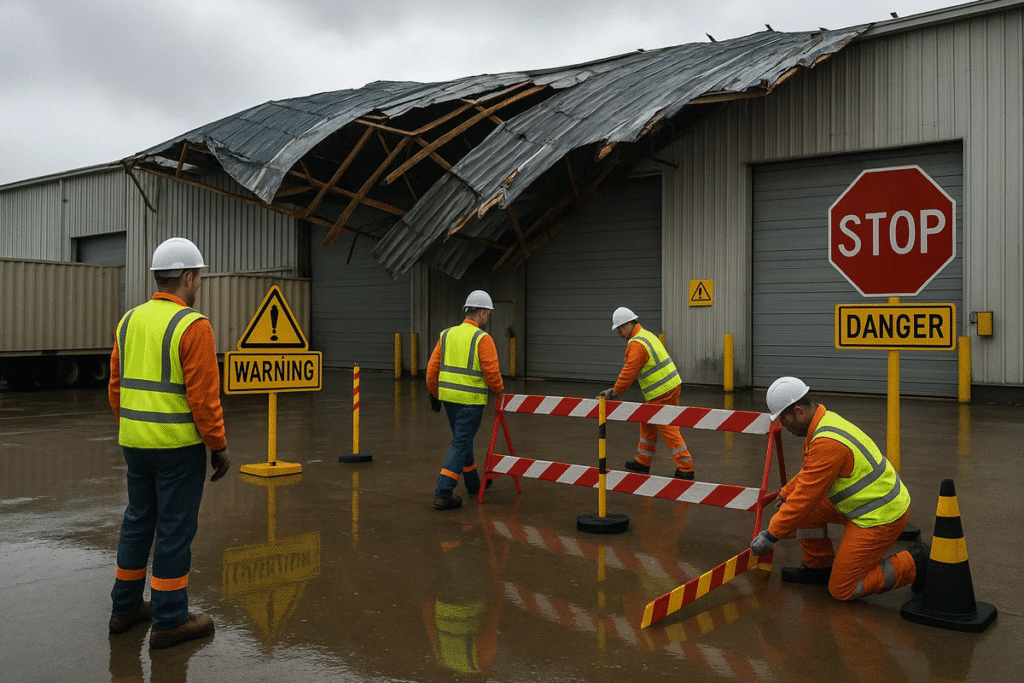
Severe Storm Damage to Fleets and Facilities

Severe weather events hurricanes, floods, winter storms pose major threats to fleets and facilities, causing both financial loss and operational disruption. In 2023, the U.S. experienced a record 28 billion-dollar weather and climate disasters, costing an estimated $92.9 billion in total (Smith, 2024).
Fleet and Transportation Risks
Fleet vehicles face threats like flooding, debris, and wind damage during storms. Drivers must be trained to adjust speed, avoid flooded roads, and secure loads safely practices highlighted in the Federal Motor Carrier Safety Administration’s hazardous weather driving tips (Federal Motor Carrier Safety Administration, 2022). Rail operations are similarly vulnerable; the Federal Railroad Administration stresses robust post-storm inspection protocols to maintain safety and service continuity (Federal Railroad Administration, 2023).
Facility Hazards and OSHA Requirements
Severe storms can lead to roof collapses, electrical hazards, and compromised structures. Employers are required to have Emergency Action Plans (EAPs) that address evacuation, shelter-in-place, and communication during emergencies (Occupational Safety and Health Administration, n.d.-a). Electrical safety is also paramount during recovery lockout/tagout and hazard assessments are essential to mitigate risks (OSHA, n.d.-b).
Environmental and Community Safety
When facilities holding hazardous materials are affected by storms, spills and releases pose serious environmental threats. The Environmental Protection Agency’s Risk Management Plan rule mandates preparedness and coordination with emergency agencies to prevent or mitigate such incidents (Environmental Protection Agency, 2023).
Building Resilience and Preparedness
FEMA’s Continuity of Operations (COOP) guidance advocates preparedness measures such as backup power systems, emergency communication lines, and alternative logistics to enhance storm resilience (Federal Emergency Management Agency, 2025.). Simple pre-storm actions like relocating fleet vehicles from flood zones and securing outdoor equipment can greatly reduce risk to assets and personnel.
Key Safety LLC Solutions
While severe storms are uncontrollable, their consequences can be managed through proactive planning. OSHA’s four safety pillars training, hazard prevention, worksite analysis, and management commitment provide a blueprint for storm resilience. At Key Safety LLC, our services include:
- Document Development for Start-up Projects: Tailored emergency action plans and protocols.
- Service on Demand: Rapid post-storm safety assessments of facilities and fleets.
- Regular Consultation Service: Long-term resilience coaching and institutional knowledge transfer.
By planning thoroughly, organizations can protect both their people and their property, even when the weather turns fierce.
References
Smith, A. B. (2024, January 8). 2023: A historic year of U.S. billion-dollar weather and climate disasters. https://www.climate.gov/news-features/blogs/beyond-data/2023-historic-year-us-billion-dollar-weather-and-climate-disasters
U.S. Environmental Protection Agency. (2023, July 21). Risk management plan (RMP) rule. https://www.epa.gov/rmp
Federal Emergency Management Agency. (2025, February 19). Continuity resource toolkit. https://www.fema.gov/emergency-managers/national-preparedness/continuity
Federal Motor Carrier Safety Administration. (2022, March). Tips for driving in hazardous weather. U.S. Department of Transportation. https://www.fmcsa.dot.gov/sites/fmcsa.dot.gov/files/2022-03/FMCSA-OROS-CMV-Driver-Toolkit-VisorCard-8×4-EW-visor1_508_Hazardous%20Weather.pdf
Federal Railroad Administration. (2023, November 24). Safety Advisory 2023-07; Review and Implement New Predictive Weather Modeling and Proactive Safety Processes Across the National Rail Network to Prevent Weather-Related Accidents and Incidents. Federal Register, 88(226), 82502. https://www.federalregister.gov/documents/2023/11/24/2023-25924/safety-advisory-2023-07-review-and-implement-new-predictive-weather-modeling-and-proactive-safety
Occupational Safety and Health Administration. (n.d.-a). Emergency preparedness and response. U.S. Department of Labor. https://www.osha.gov/emergency-preparedness/getting-started
Occupational Safety and Health Administration. (n.d.-b). Control of hazardous energy (lockout/tagout) and Electrical. U.S. Department of Labor. https://www.osha.gov/control-hazardous-energy
Comments:

